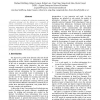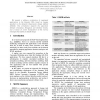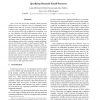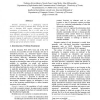WWW
2004
ACM
15 years 8 days ago
2004
ACM
A web portal is a platform for information presentation and information exchange over the Internet in a community of interest. Conventional web technologies used in web portals pr...
WWW
2004
ACM
15 years 8 days ago
2004
ACM
We present a software architecture to implement applications in the Semantic Web, based on designs specified in the Semantic Hypermedia Design Method (SHDM). This architecture sup...
WWW
2004
ACM
15 years 8 days ago
2004
ACM
To be able to realize the vision of the semantic web an important bottleneck that needs to be solved is an easy and intuitive approach for the annotation of websites with semantic...
WWW
2004
ACM
15 years 8 days ago
2004
ACM
WWW
2004
ACM
15 years 8 days ago
2004
ACM
A Web Application must have a precise semantics. In currently Web Engineering environments, this can be achieved either by specifying a Web Conceptual Schema, or by using a Semant...
WWW
2004
ACM
15 years 8 days ago
2004
ACM
The integration of four design attributes (componentcost, quality, function, and technology) streamlines product design by providing a multilateral view to designers that leads to...
WWW
2004
ACM
15 years 8 days ago
2004
ACM
Prior work has shown that semantic email processes (SEPs) can be an effective tool for automating emailmediated tasks that are currently performed manually in a tedious, time-cons...
WWW
2004
ACM
15 years 8 days ago
2004
ACM
Designing web sites is a complex task. Ad-hoc rapid prototyping easily leads to unsatisfactory results, e.g. poor maintainability and extensibility. However, existing web design f...
WWW
2004
ACM
15 years 8 days ago
2004
ACM
This paper discusses the possibilities of the Semantic Web technologies in both annotating services and delivering relevant services to end-users. We propose an ontologybased mech...
WWW
2004
ACM
15 years 8 days ago
2004
ACM
Semantic Annotation is a challenging research direction in the area of Semantic Web. Turning the web into a Semantic Web implies widespread semantic annotation of documents. But i...





